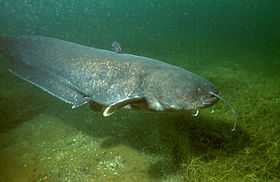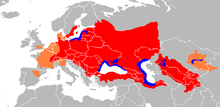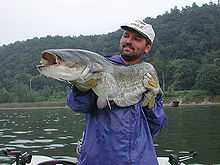Wels catfish
| Wels catfish | |
|---|---|
 | |
| Conservation status | |
| Scientific classification | |
| Kingdom: | Animalia |
| Phylum: | Chordata |
| Class: | Actinopterygii |
| Order: | Siluriformes |
| Family: | Siluridae |
| Genus: | Silurus |
| Species: | S. glanis |
| Binomial name | |
| Silurus glanis Linnaeus, 1758 | |
 | |
| Range of the wels catfish. Red: native occurrence. Blue: occurrence in coastal waters. Orange: introduced | |
The wels catfish (/ˈwɛls/ or /ˈvɛls/; Silurus glanis), also called sheatfish, is a large catfish found in wide areas of central, southern, and eastern Europe, and near the Baltic and Caspian Seas. It is found from the United Kingdom all the way east to Kazakhstan and south to Greece. It is a scaleless fresh and brackish water fish recognizable by its broad, flat head and wide mouth. Wels catfish can live for at least thirty years and have very good hearing.
The wels catfish lives on annelid worms, gastropods, insects, crustaceans, and fish including other catfishes; the larger ones also eat frogs, mice, rats, and aquatic birds such as ducks. Recently, individuals of this species in environments that are not their native habitats have been observed lunging out of the water to grab pigeons on land.[1]
Habitat
The wels catfish lives in large, warm lakes and deep, slow-flowing rivers. It prefers to remain in sheltered locations such as holes in the riverbed, sunken trees, etc. It consumes its food in the open water or in the deep, where it can be recognized by its large mouth. Wels catfish are kept in fish ponds as food fish.
Physical characteristics
Wels catfish's mouth contains lines of numerous small teeth, two long barbels on the upper jaw and four shorter barbels on the lower jaw. It has a long anal fin that extends to the caudal fin, and a small sharp dorsal fin positioned relatively far forward. It uses its sharp pectoral fins to capture prey. With these fins, it creates an eddy to disorient its victim, which it then simply engulfs in its enormous throat. It has very slippery green-brown skin. Its belly is pale yellow or white. Colour varies with environment. Clear water will give the fish a black coloration while muddy water will often tend to produce brownish specimens. Weight and length are not correlated linearly, and also depend on the season.
The female produces up to 30,000 eggs per kilogram of body weight. The male guards the nest until the brood hatches, which, depending on water temperature, can take from three to ten days. If the water level decreases too much or too fast the male has been observed to splash the eggs with the muscular tail in order to keep them wet.[citation needed]
Size
%2C_%D0%A1%D1%8B%D1%80%D0%B4%D0%B0%D1%80%D0%B8%D1%8F%2C_%D0%91%D0%B0%D0%B9%D2%9B%D0%BE%D2%A3%D1%8B%D1%80.jpg)

With a possible total length up to 4 m (13 ft) and a maximum weight of over 180 kg (400 lb) it is the second largest freshwater fish in its region after the beluga sturgeon. However, such lengths are extremely rare and could not be proved during the last century, but there is a somewhat credible report from the 19th century of a wels catfish of this size. Brehms Tierleben cites Heckl's and Kner's old reports from Danube about specimens 3 m (9.8 ft) long and 200–250 kg (440–550 lb) in weight, and Vogt's 1894 report of a specimen caught in Lake Biel which was 2.2 m (7 ft 3 in) long and weighed 68 kg (150 lb).[2] In 1856, K. T. Kessler[3] wrote about specimens from Dniepr which were over 5 m (16 ft) long and weighed up to 400 kg (880 lb).
Most wels catfish are only about 1.3–1.6 m (4 ft 3 in–5 ft 3 in) long; fish longer than 2 m (6 ft 7 in) are normally extremely rare. At 1.5 m (4 ft 11 in) they can weigh 15–20 kg (33–44 lb) and at 2.2 m (7 ft 3 in) they can weigh 65 kg (143 lb).
Only under exceptionally good living circumstances can the wels catfish reach lengths of more than 2 m (6 ft 7 in), as with the record wels catfish of Kiebingen (near Rottenburg, Germany), which was 2.49 m (8 ft 2 in) long and weighed 89 kg (196 lb). This giant was surpassed by some even larger specimens from Poland (2,61 m. 109 kg.), Ukraine, France, Spain (in the River Ebro), Italy (in the Po River and Arno River), and Greece, where this fish was released a few decades ago. Greek wels grow well thanks to the mild climate, lack of competition, and good food supply. The largest accurate weight was 144 kg (317 lb) for a 2.78 m (9 ft 1 in) long specimen from the Po Delta in Italy.[4] Other reports of larger wels (around 5 m (16 ft) or more) are unlikely and are often regarded as typical big fish stories or in some cases misidentification of the now rare sturgeon.
Exceptionally large specimens are rumored to attack humans in rare instances, a claim investigated by extreme angler Jeremy Wade in an episode of the Animal Planet television series River Monsters following his capture of three fish, two of about 66 kg (145 lb) and one of about 73 kg (160 lb), of which two attempted to attack him following their release. A report in the Austrian newspaper Der Standard on 5 August 2009, mentions a wels catfish dragging a fisherman near Győr, Hungary, under water by his right leg after the man attempted to grab the fish in a hold. The man barely escaped with his life from the fish, which must have weighed over 100 kg (220 lb), according to the fisherman.[5]
Ecology
There are concerns about the ecological impact of introducing the wels catfish to non-native regions. These concerns take into account the situation in Lake Victoria in Africa, where Nile perch (available in stores as Lake Victoria perch) were introduced and rapidly caused the extinction of numerous indigenous species. This severely impacted the entire lake, destroying much of the original ecosystem. The introduction of foreign species is almost always a burden on the affected ecosystem. Following the introduction of wels catfish, some fishes' numbers are in clear and rapid decline. Since its introduction in the Mequinenza Reservoir in 1974, it has spread to other parts of the Ebro basin, including Ebro and its tributaries, especially the Segre River. Some endemic species of Iberian barbels, genus Barbus in the Cyprinidae, were once abundant especially in the Ebro river but due to competition from and predation by wels catfish have since disappeared in the middle channel Ebro. The ecology of the river has also changed, as there is now a major growth in aquatic vegetation such as seaweed and algae. Barbel species from mountain stream tributaries of the Ebro that wels catfish have not colonized are not affected.
As a food fish
Only the flesh of young Silurus glanis specimens is valued as food. It is palatable when the catfish weighs less than 15 kg (33 lb). Larger than this size, the fish is highly fatty and not recommended for consumption.
Related species
- Aristotle's catfish (Silurus aristotelis) from Greece, the only other native European catfish species beside Silurus glanis.
- Amur catfish (Silurus asotus), introduced to European rivers
- Giant lake biwa catfish (Silurus biwaensis) from Japan endemic to Lake Biwa.
- Silurus soldatovi from Russia
- Mekong giant catfish on the lower reaches of the Mekong
References
- ↑ Cucherousset, J.; Boulêtreau, S. P.; Azémar, F. D. R.; Compin, A.; Guillaume, M.; Santoul, F. D. R. (2012). ""Freshwater Killer Whales": Beaching Behavior of an Alien Fish to Hunt Land Birds". In Steinke, Dirk. PLoS ONE 7 (12): e50840. doi:10.1371/journal.pone.0050840.
- ↑ Brehm, Alfred; Brehms Tierleben II - Fish, Amphibians, Reptiles 1
- ↑ Mareš, Jaroslav; Legendární příšery a skutečná zvířata, Prague, 1993
- ↑ Wood, Gerald C. (1982). The Guinness book of animal facts and feats. Enfield, Middlesex: Guinness Superlatives. ISBN 0-85112-235-3.
- ↑ Der Standard, 2009-08-05. Waller-Wrestling im ungarischen Fischerteich. Retrieved 2009-08-06. (German)
Additional reading
- World Conservation Monitoring Centre (1996). Silurus glanis. 2006. IUCN Red List of Threatened Species. IUCN 2006. www.iucnredlist.org. Retrieved on 9 May 2006.
- Froese, Rainer and Pauly, Daniel, eds. (2006). "Silurus glanis" in FishBase. March 2006 version.
- "Silurus glanis". Integrated Taxonomic Information System. Retrieved 19 March 2006.
External links
| Wikimedia Commons has media related to Silurus glanis. |
| Wikispecies has information related to: Silurus glanis |
- This article includes information translated out of the German and French Wikipedias.
